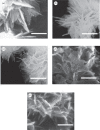The role of amino acids in hydroxyapatite mineralization
- PMID: 27707904
- PMCID: PMC5095212
- DOI: 10.1098/rsif.2016.0462
The role of amino acids in hydroxyapatite mineralization
Abstract
Polar and charged amino acids (AAs) are heavily expressed in non-collagenous proteins (NCPs), and are involved in hydroxyapatite (HA) mineralization in bone. Here, we review what is known on the effect of single AAs on HA precipitation. Negatively charged AAs, such as aspartic acid, glutamic acid (Glu) and phosphoserine are largely expressed in NCPs and play a critical role in controlling HA nucleation and growth. Positively charged ones such as arginine (Arg) or lysine (Lys) are heavily involved in HA nucleation within extracellular matrix proteins such as collagen. Glu, Arg and Lys intake can also increase bone mineral density by stimulating growth hormone production. In vitro studies suggest that the role of AAs in controlling HA precipitation is affected by their mobility. While dissolved AAs are able to inhibit HA precipitation and growth by chelating Ca2+ and PO43- ions or binding to nuclei of calcium phosphate and preventing their further growth, AAs bound to surfaces can promote HA precipitation by attracting Ca2+ and PO43- ions and increasing the local supersaturation. Overall, the effect of AAs on HA precipitation is worth being investigated more, especially under conditions closer to the physiological ones, where the presence of other factors such as collagen, mineralization inhibitors, and cells heavily influences HA precipitation. A deeper understanding of the role of AAs in HA mineralization will increase our fundamental knowledge related to bone formation, and could lead to new therapies to improve bone regeneration in damaged tissues or cure pathological diseases caused by excessive mineralization in tissues such as cartilage, blood vessels and cardiac valves.
Keywords: amino acids; biomineralization; hydroxyapatite.
© 2016 The Author(s).
Figures




Similar articles
-
Hydroxyapatite formation on graphene oxide modified with amino acids: arginine versus glutamic acid.J R Soc Interface. 2016 Jan;13(114):20150986. doi: 10.1098/rsif.2015.0986. J R Soc Interface. 2016. PMID: 26791001 Free PMC article.
-
The importance of amino acid interactions in the crystallization of hydroxyapatite.J R Soc Interface. 2012 Dec 26;10(80):20120906. doi: 10.1098/rsif.2012.0906. Print 2013 Mar 6. J R Soc Interface. 2012. PMID: 23269851 Free PMC article.
-
L-histidine controls the hydroxyapatite mineralization with plate-like morphology: Effect of concentration and media.Mater Sci Eng C Mater Biol Appl. 2021 Jan;120:111669. doi: 10.1016/j.msec.2020.111669. Epub 2020 Oct 22. Mater Sci Eng C Mater Biol Appl. 2021. PMID: 33545834
-
In vitro models of collagen biomineralization.J Struct Biol. 2013 Aug;183(2):258-69. doi: 10.1016/j.jsb.2013.04.003. Epub 2013 Apr 15. J Struct Biol. 2013. PMID: 23597833 Review.
-
Biomineralization of bone: a fresh view of the roles of non-collagenous proteins.Front Biosci (Landmark Ed). 2011 Jun 1;16(7):2598-621. doi: 10.2741/3875. Front Biosci (Landmark Ed). 2011. PMID: 21622198 Free PMC article. Review.
Cited by
-
Hydroxyapatite-Tethered Peptide Hydrogel Promotes Osteogenesis.Gels. 2022 Dec 8;8(12):804. doi: 10.3390/gels8120804. Gels. 2022. PMID: 36547328 Free PMC article.
-
Role of Aspartic and Polyaspartic Acid on the Synthesis and Hydrolysis of Brushite.J Funct Biomater. 2019 Feb 1;10(1):11. doi: 10.3390/jfb10010011. J Funct Biomater. 2019. PMID: 30717259 Free PMC article.
-
Advances in biomimetic collagen mineralisation and future approaches to bone tissue engineering.Biopolymers. 2023 Jan;114(1):e23527. doi: 10.1002/bip.23527. Epub 2022 Nov 29. Biopolymers. 2023. PMID: 36444710 Free PMC article. Review.
-
Influence of Hydroxyapatite Surface Functionalization on Thermal and Biological Properties of Poly(l-Lactide)- and Poly(l-Lactide-co-Glycolide)-Based Composites.Int J Mol Sci. 2020 Sep 13;21(18):6711. doi: 10.3390/ijms21186711. Int J Mol Sci. 2020. PMID: 32933206 Free PMC article.
-
Bone-Targeting Systems to Systemically Deliver Therapeutics to Bone Fractures for Accelerated Healing.Curr Osteoporos Rep. 2020 Oct;18(5):449-459. doi: 10.1007/s11914-020-00604-4. Curr Osteoporos Rep. 2020. PMID: 32860563 Free PMC article. Review.
References
-
- Rosenthal AK. 2007. The role of noncollagenous proteins in mineralization. Curr. Opin. Orthopaed. 18, 449–453. (10.1097/BCO.0b013e32825e1d84) - DOI
Publication types
MeSH terms
Substances
LinkOut - more resources
Full Text Sources
Other Literature Sources
Medical
Miscellaneous

